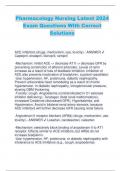Pharmacology Nursing Latest 2024
Exam Questions With Correct
Solutions
ACE inhibitors (drugs, mechanism, use, toxicity) - ANSWER ✔
Captopril, enalapril, lisinopril, ramipril
-Mechanism: inhibit ACE -> decrease AT II -> decrease GFR by
preventing constriction of efferent arterioles. Levels of renin
increase as a result of loss of feedback inhibition. Inhibition of
ACE also prevents inactivation of bradykinin, a potent vasodilator.
-Use: hypertension, HF, proteinuria, diabetic nephropathy.
Prevent unfavorable heart remodeling as a result of chronic
hypertension. In diabetic nephropathy, intraglomerular pressure,
slowing GBM thickening
-Toxicity: cough, Angioedema (contraindicated in C1 esterase
inhibitor deficiency), Teratogen (fetal renal malformations),
increased Creatinine (decreased GFR), Hyperkalemia, and
Hypotension. Avoid in bilateral renal artery stenosis, because
ACE inhibitors will further decrease GFR causing renal failure.
Angiotensin II receptor blockers (ARBs) (drugs, mechanism, use,
toxicity) - ANSWER ✔ Losartan, candesartan, valsartan
-Mechanism: selectively block binding of angiotensin II to AT1
receptor. Effects similar to ACE inhibitors, but ARBs do not
increase bradykinin.
-Use: hypertension, HF, proteinuria, or diabetic nephropathy with
intolerance to ACE inhibitors (e.g., cough, angioedema).
,-Toxicity: hyperkalemia, decreased renal function, hypotension;
teratogen.
Aliskiren (mechanism, use, toxicity) - ANSWER ✔ -Mechanism:
direct renin inhibitor, blocks conversion of angiotensinogen to
angiotensin I.
-Use: hypertension
-Toxicity: hyperkalemia, decreased renal function, hypotension.
-Contraindicated in diabetics taking ACE inhibitors or ARBs.
Control of reproductive hormones schematic - ANSWER ✔
Leuprolide (mechanism, use, toxicity) - ANSWER ✔ -Mechanism:
GnRH analog with agonist properties
when used in pulsatile fashion; antagonist properties when used
in continuous fashion (downregulates GnRH receptor in pituitary
causing decreased FSH/LH).
-Use: infertility (pulsatile), prostate cancer (continuous use
following androgen receptor blockade with flutamide), uterine
fibroids (continuous), precocious puberty (continuous).
-Toxicity: antiandrogen, nausea, vomiting.
Estrogens (ethinyl estradiol, DES, mestranol) (mechanism, use,
toxicity) - ANSWER ✔ -Mechanism: bind estrogen receptors.
-Use: hypogonadism or ovarian failure, menstrual abnormalities,
hormone replacement therapy in postmenopausal women; use in
men with androgen-dependent prostate cancer.
-Toxicity: increased risk of endometrial cancer, bleeding in
postmenopausal women, clear cell adenocarcinoma of vagina in
females exposed to DES in utero, increased risk of thrombi.
-Contraindications—ER ⊕ breast cancer, history of DVTs
, Clomiphene (mechanism, use, toxicity) - ANSWER ✔ -
Mechanism: antagonist at estrogen receptors in hypothalamus.
Prevents normal feedback inhibition and
release of LH and FSH from pituitary, which stimulates ovulation.
-Use: to treat infertility due to anovulation (e.g., PCOS). ----
Toxicity: may cause hot flashes, ovarian enlargement, multiple
simultaneous pregnancies, visual disturbances.
Tamoxifen (mechanism, use, toxicity) - ANSWER ✔ -Mechanism:
antagonist at breast; agonist at bone, uterus;
-Used to treat and prevent recurrence of ER/PR ⊕ breast cancer;
-Increased risk of thromboembolic events and endometrial cancer
(as opposed to raloxifine)
Raloxifene (mechanism, use, toxicity) - ANSWER ✔ -Mechanism:
antagonist at breast, uterus; agonist at bone; -Use: primarily to
treat osteoporosis
-Increased risk of thromboembolic events but no increased risk of
endometrial cancer (vs. tamoxifen);
Hormone replacement therapy - ANSWER ✔ -Used for relief or
prevention of menopausal symptoms (e.g., hot flashes, vaginal
atrophy), osteoporosis (increased estrogen, decreased osteoclast
activity).
-Unopposed estrogen replacement therapy increases risk of
endometrial cancer, so progesterone is added. Possible
increased cardiovascular risk.
Anastrozole/ exemestane - ANSWER ✔ Aromatase inhibitors
used in postmenopausal women with ER ⊕ breast cancer.
Progestins (mechanism, use) - ANSWER ✔ -Mechanism: bind
progesterone receptors, decrease growth and increase
vascularization of the endometrium
, -Used in oral contraceptives and to treat endometrial cancer,
abnormal uterine bleeding.
Mifepristone (RU-486) (mechanism, use, toxicity) - ANSWER ✔ -
Mechanism: competitive inhibitor of progestins at progesterone
receptors.
-Use: termination of pregnancy. Administered with misoprostol
(PGE1).
Toxicity: heavy bleeding, GI effects (nausea, vomiting, anorexia),
abdominal pain.
Oral contraception (synthetic progestins, estrogen) - ANSWER ✔
-Estrogen and progestins inhibit LH/FSH and thus prevent
estrogen surge. No estrogen surge, then no LH surge then no
ovulation.
-Progestins cause thickening of cervical mucus, thereby limiting
access of sperm to uterus. Progestins also inhibit endometrial
proliferation -> endometrium is less suitable to the implantation of
an embryo.
-Contraindications: smokers > 35 years old (increased risk of
cardiovascular events), patients with history of thromboembolism
and stroke or history of estrogen-dependent tumor.
Terbutaline, ritodrine - ANSWER ✔ β2-agonists that relax the
uterus; used to contraction frequency in women during labor.
Danazol (mechanism, use, toxicity) - ANSWER ✔ -Mechanism:
synthetic androgen that acts as partial agonist at androgen
receptors.
-Use: endometriosis, hereditary angioedema.
-Toxicity: weight gain, edema, acne, hirsutism, masculinization,
decreased HDL levels, hepatotoxicity.




